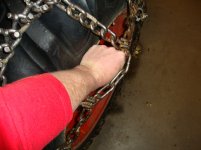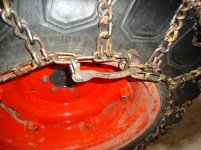OP
caspar3259
Bronze Member
Ive been looking at your chain situation and my question to you is your inside connection looser thus forcing you to over tighten the outside side link?
I tightened the inside first and on one tire the inside is on the exact same link, and on the other tire it is one link "looser".
I drove around the driveway twice and they are about as tight as I can get them by hand.
I assume they are the right size as I clicked on the 12.4-24 link on tirechains.com and that is the size stamped on the side of the tire. I believe the bags were labeled #229, which is probably a tirechains.com stock #.
I think I'll just use them as-is, with the exception of adding tensioners. It's kinda strange to have one cross chain loose because it's "outside" the buckle.
-Jeff


